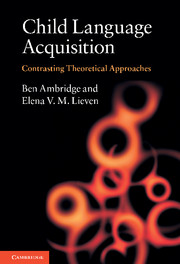Book contents
- Frontmatter
- Contents
- List of figures
- List of tables
- List of boxes
- List of summary tables
- Preface
- Acknowledgements
- 1 Introduction
- 2 Speech perception, segmentation and production
- 3 Learning word meanings
- 4 Theoretical approaches to grammar acquisition
- 5 Inflection
- 6 Simple syntax
- 7 Movement and complex syntax
- 8 Binding, quantification and control
- 9 Related debates and conclusions
- Notes
- References
- Author index
- Subject index
6 - Simple syntax
Published online by Cambridge University Press: 05 June 2012
- Frontmatter
- Contents
- List of figures
- List of tables
- List of boxes
- List of summary tables
- Preface
- Acknowledgements
- 1 Introduction
- 2 Speech perception, segmentation and production
- 3 Learning word meanings
- 4 Theoretical approaches to grammar acquisition
- 5 Inflection
- 6 Simple syntax
- 7 Movement and complex syntax
- 8 Binding, quantification and control
- 9 Related debates and conclusions
- Notes
- References
- Author index
- Subject index
Summary
A sentence is not simply a set of words (e.g. cat, dog, bit), but also contains the grammatical information necessary to allow the listener to determine ‘who did what to whom’ (and also whether the utterance is a statement or a question, and so on). As we saw in the previous chapter, many languages convey this information by means of morphology (e.g. nominative and accusative noun markers). Many languages, with English being a prime example, instead rely primarily on word order. For example, basic declarative English sentences use SUBJECT–VERB–OBJECT word order to mark the AGENT, ACTION and PATIENT of an event respectively (e.g. The dog bit the cat means something different to The cat bit the dog). Although some languages (arguably) exhibit entirely ‘free’ word order (i.e. all word orders are possible, equally common and convey the same meaning), most retain a ‘default’ word order that is used for the majority of basic declarative sentences (and which guides interpretation when case marking is not present), even when case marking makes word-order information redundant.
Our main focus in this chapter is the question of how children learning word-order languages acquire the word-order ‘rules’ of their language. However, we will also discuss data from languages in which morphological cues to meaning override word-order information. We focus here on simple sentences: sentences with only one clause (e.g. The dog bit the cat).
Information
- Type
- Chapter
- Information
- Child Language AcquisitionContrasting Theoretical Approaches, pp. 191 - 268Publisher: Cambridge University PressPrint publication year: 2011
